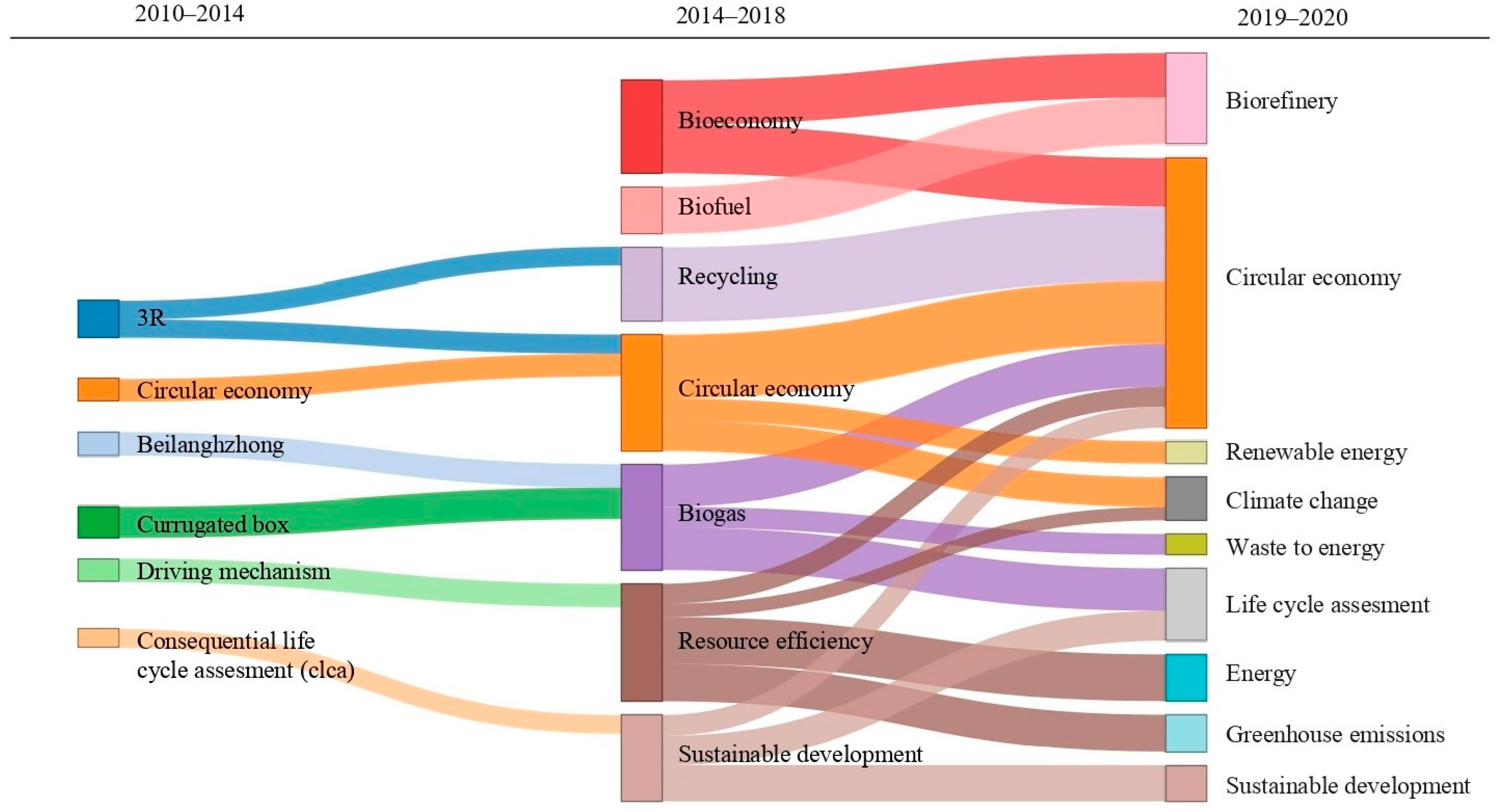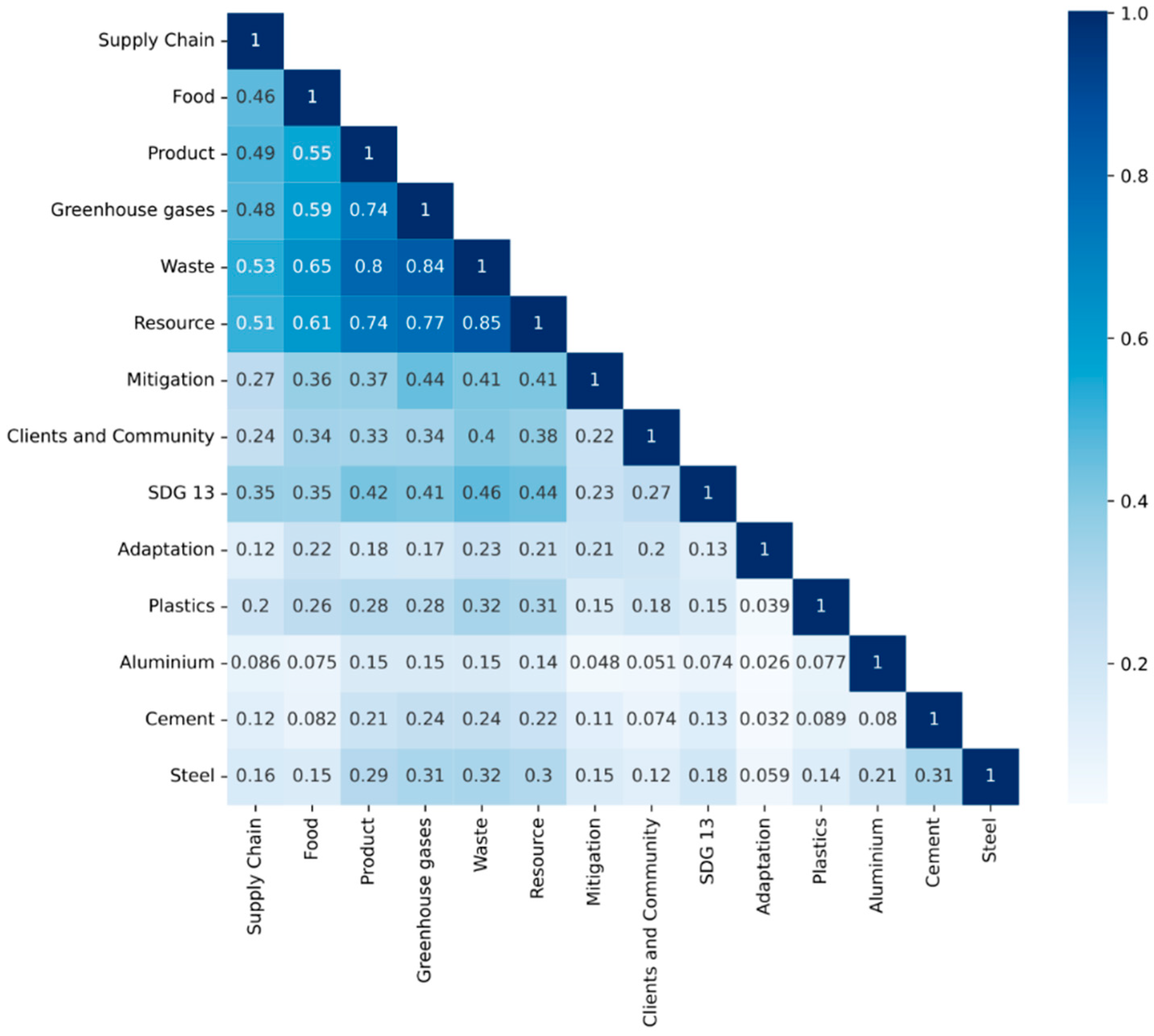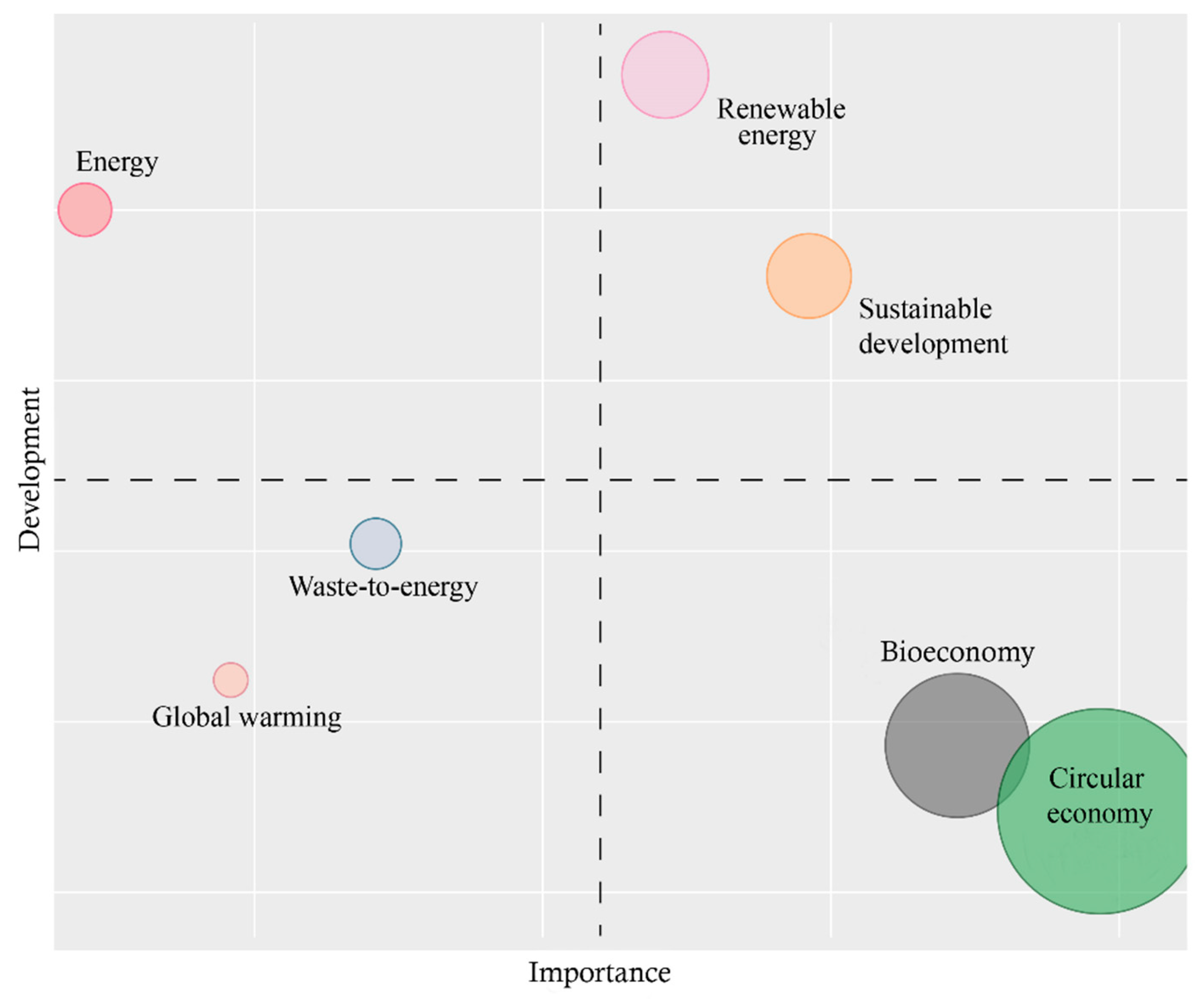Research Trends on Climate Change and Circular Economy from a Knowledge Mapping Perspective
Abstract
:1. Introduction
2. Materials and Methods
2.1. Literature Search Strategy
2.2. Bibliometric Analysis
2.3. Scientometric Analysis
2.4. Landscape Scientific Method
2.5. Text Mining Analysis
3. Results
3.1. Trends in the Number of Publications and Subject Areas
3.2. Most Relevant Countries, Institutions, Authors, and Funding Sponsors
3.3. Most Influential Journals and Publications
3.4. Evolutionary Keyword Path
3.5. Association among Climate Actions, CE Strategies, Highly GHG-Emitting Materials, and SDG 13
3.6. The Research Lines Hotspots
4. Discussion
4.1. Key Findings and Their Implications
4.2. Research Lines, Knowledge Gaps, and Prospects
5. Conclusions
Supplementary Materials
Author Contributions
Funding
Institutional Review Board Statement
Informed Consent Statement
Data Availability Statement
Acknowledgments
Conflicts of Interest
References
- O’Neill, B.C.; Carter, T.R.; Ebi, K.; Harrison, P.A.; Kemp-Benedict, E.; Kok, K.; Kriegler, E.; Preston, B.L.; Riahi, K.; Sillmann, J.; et al. Achievements and needs for the climate change scenario framework. Nat. Clim. Chang. 2020, 10, 1074–1084. [Google Scholar] [CrossRef]
- Ogunbode, C.A.; Doran, R.; Böhm, G. Exposure to the IPCC special report on 1.5 C global warming is linked to perceived threat and increased concern about climate change. Clim. Chang. 2020, 158, 361–375. [Google Scholar] [CrossRef]
- Olivier, J.; Peters, J. Trends in Global CO2 and Total Greenhouse Gas Emissions: 2020 Report; PBL Netherlands Environmental Assessment Agency: The Hague, The Netherlands, 2020. [Google Scholar]
- Caldas, L.R.; Saraiva, A.B.; Lucena, A.F.; Da Gloria, M.H.Y.; Santos, A.S.; Toledo Filho, R.D. Building materials in a circular economy: The case of wood waste as CO2-sink in bio concrete. Resour. Conserv. Recycl. 2021, 166, 105346. [Google Scholar] [CrossRef]
- Khan, I.S.; Ahmad, M.O.; Majava, J. Industry 4.0 and sustainable development: A systematic mapping of triple bottom line, Circular Economy and Sustainable Business Models perspectives. J. Clean. Prod. 2021, 297, 126655. [Google Scholar] [CrossRef]
- Material Economics. Available online: https://materialeconomics.com/publications/the-circular-economy-a-powerful-force-for-climate-mitigation-1 (accessed on 30 July 2021).
- Circle Economy. The Circularity Gap Report. Available online: https://www.circle-economy.com/resources/circularity-gap-report-2020#:~:text=The%20Circularity%20Gap%20Report%202020,was%20first%20launched%20in%202018 (accessed on 30 July 2021).
- Wan, B.; Tian, L.; Fu, M.; Zhang, G. Green development growth momentum under carbon neutrality scenario. J. Clean. Prod. 2021, 316, 128327. [Google Scholar] [CrossRef]
- United Nations Development Programme. A 1.5 °C World Requires a Circular and Low Carbon Economy. Available online: https://www.ndcs.undp.org/content/ndc-support-programme/en/home/impact-and-learning/library/a-1-5-c-world-requires-a-circular-and-low-carbon-economy.html (accessed on 30 July 2021).
- Deloitte. Circular Economy Potential for Climate Change Mitigation. Available online: https://www2.deloitte.com/content/dam/Deloitte/fi/Documents/risk/Deloitte%20-%20Circular%20economy%20and%20Global%20Warming.pdf (accessed on 30 July 2021).
- Stahel, W.R. The circular economy. Nature 2016, 531, 435–438. [Google Scholar] [CrossRef] [PubMed] [Green Version]
- Korhonen, J.; Nuur, C.; Feldmann, A.; Birkie, S.E. Circular economy as an essentially contested concept. J. Clean. Prod. 2018, 175, 544–552. [Google Scholar] [CrossRef]
- Geissdoerfer, M.; Savaget, P.; Bocken, N.M.; Hultink, E.J. The Circular Economy–A new sustainability paradigm? J. Clean. Prod. 2017, 143, 757–768. [Google Scholar] [CrossRef] [Green Version]
- Grafström, J.; Aasma, S. Breaking circular economy barriers. J. Clean. Prod. 2021, 292, 126002. [Google Scholar] [CrossRef]
- Ellen MacArthur Foundation. Completing the Picture: How the Circular Economy Tackles Climate Change. Available online: www.ellenmacarthurfoundation.org/publications (accessed on 21 July 2021).
- Hobson, K.; Holmes, H.; Welch, D.; Wheeler, K.; Wieser, H. Consumption Work in the circular economy: A research agenda. J. Clean. Prod. 2021, 321, 128969. [Google Scholar] [CrossRef]
- Yadav, G.; Mangla, S.K.; Bhattacharya, A.; Luthra, S. Exploring indicators of circular economy adoption framework through a hybrid decision support approach. J. Clean. Prod. 2020, 277, 124186. [Google Scholar] [CrossRef]
- Betancourt-Morales, C.M.; Zartha-Sossa, J.W. Circular economy in Latin America: A systematic literature review. Bus. Strateg. Environ. 2020, 29, 2479–2497. [Google Scholar] [CrossRef]
- McDowall, W.; Geng, Y.; Huang, B.; Barteková, E.; Bleischwitz, R.; Türkeli, S.; Kempo, R.; Doménech, T. Circular economy policies in China and Europe. J. Ind. Ecol. 2017, 21, 651–661. [Google Scholar] [CrossRef] [Green Version]
- Ranjbari, M.; Saidani, M.; Esfandabadi, Z.S.; Peng, W.; Lam, S.S.; Aghbashlo, M.; Quatraro, F.; Tabatabaei, M. Two decades of research on waste management in the circular economy: Insights from bibliometric, text mining, and content analyses. J. Clean. Prod. 2021, 314, 128009. [Google Scholar] [CrossRef]
- Cantzler, J.; Creutzig, F.; Ayargarnchanakul, E.; Javaid, A.; Wong, L.; Haas, W. Saving resources and the climate? A systematic review of the circular economy and its mitigation potential. Environ. Res. Lett. 2020, 15, 123001. [Google Scholar] [CrossRef]
- Díaz-López, C.; Carpio, M.; Martín-Morales, M.; Zamorano, M. Defining strategies to adopt Level(s) for bringing buildings into the circular economy. A case study of Spain. J. Clean. Prod. 2021, 287, 125048. [Google Scholar] [CrossRef]
- Gallego-Schmid, A.; Chen, H.M.; Sharmina, M.; Mendoza, J.M.F. Links between circular economy and climate change mitigation in the built environment. J. Clean. Prod. 2020, 260, 121115. [Google Scholar] [CrossRef]
- Christis, M.; Athanassiadis, A.; Vercalsteren, A. Implementation at a city level of circular economy strategies and climate change mitigation–the case of Brussels. J. Clean. Prod. 2019, 218, 511–520. [Google Scholar] [CrossRef]
- Circular Economy Action Plan—European Commission. Available online: https://ec.europa.eu/environment/strategy/circular-economy-action-plan_es (accessed on 7 December 2021).
- Serrano, T.; Aparcana, S.; Bakhtiari, F.; Laurent, A. Contribution of circular economy strategies to climate change mitigation: Generic assessment methodology with focus on developing countries. J. Ind. Ecol. 2021, 25, 1382–1397. [Google Scholar] [CrossRef]
- Velasco-Muñoz, J.F.; Mendoza, J.M.F.; Aznar-Sánchez, J.A.; Gallego-Schmid, A. Circular economy implementation in the agricultural sector: Definition, strategies and indicators. Resour. Conserv. Recycl. 2021, 170, 105618. [Google Scholar] [CrossRef]
- Abramo, G.; D’Angelo, C.A.; Reale, E. Peer review versus bibliometrics: Which method better predicts the scholarly impact of publications? Scientometrics 2019, 121, 537–554. [Google Scholar] [CrossRef] [Green Version]
- Szomszor, M.; Adams, J.; Fry, R.; Gebert, C.; Pendlebury, D.A.; Potter, R.W.; Rogers, G. Interpreting bibliometric data. Front. Res. Metr. Anal. 2021, 5, 628703. [Google Scholar] [CrossRef] [PubMed]
- Miyashita, S.; Sengoku, S. Scientometrics for management of science: Collaboration and knowledge structures and complexities in an interdisciplinary research project. Scientometrics 2021, 126, 7419–7444. [Google Scholar] [CrossRef]
- Huang, Y.; Glänzel, W.; Zhang, L. Tracing the development of mapping knowledge domains. Scientometrics 2021, 126, 6201–6224. [Google Scholar] [CrossRef]
- Morales, M.E.; Batlles-de la Fuente, A.; Cortés-García, F.J.; Belmonte-Ureña, L.J. Theoretical research on circular economy and sustainability trade-offs and synergies. Sustainability 2021, 13, 11636. [Google Scholar] [CrossRef]
- Wacholder, N. Interactive Query Formulation. Annu. Rev. Inform. Sci. Technol. 2011, 45, 157–196. [Google Scholar] [CrossRef]
- Subramanyam, K. Bibliometric studies of research collaboration: A review. J. Inf. Sci. 1983, 6, 33–38. [Google Scholar] [CrossRef]
- Park, J.Y.; Nagy, Z. Comprehensive analysis of the relationship between thermal comfort and building control research-A data-driven literature review. Renew. Sustain. Energy Rev. 2018, 82, 2664–2679. [Google Scholar] [CrossRef]
- Aria, M.; Cuccurullo, C. Bibliometrix: An R-tool for comprehensive science mapping analysis. J. Informetr. 2017, 11, 959–975. [Google Scholar] [CrossRef]
- Flórez-Martínez, D.H.; Contreras-Pedraza, C.A.; Rodríguez, J. A systematic analysis of non-centrifugal sugar cane processing: Research and new trends. Trends Food Sci. Technol. 2020, 107, 415–428. [Google Scholar] [CrossRef]
- Cobo, M.J.; López-Herrera, A.G.; Herrera-Viedma, E.; Herrera, F. An approach for detecting, quantifying, and visualizing the evolution of a research field: A practical application to the fuzzy sets theory field. J. Informetr. 2011, 5, 146–166. [Google Scholar] [CrossRef]
- Lupton, R.C.; Allwood, J.M. Hybrid Sankey diagrams: Visual analysis of multidimensional data for understanding resource use. Resour. Conserv. Recycl. 2017, 124, 141–151. [Google Scholar] [CrossRef]
- De Selliers, D.; Spataru, C. Corporate Strategies for a Circular Economy: A Comparative Study of Energy Companies. In Proceedings of the 2nd International Conference on Applied Research in Management, Economics and Accounting (IARMEA 2019), Brussels, Belgium, 5–7 June 2019; Diamond Scientific Publication: Vilnius, Lithuania, 2019; pp. 28–47. [Google Scholar]
- Hu, G.; Wang, L.; Ni, R.; Liu, W. Which h-index? An exploration within the Web of Science. Scientometrics 2020, 123, 1225–1233. [Google Scholar] [CrossRef]
- Rodriguez-Anton, J.M.; Rubio-Andrada, L.; Celemín-Pedroche, M.S.; Alonso-Almeida, M.D.M. Analysis of the relations between circular economy and sustainable development goals. Int. J. Sustain. Dev. 2019, 26, 708–720. [Google Scholar] [CrossRef]
- Schroeder, P.; Anggraeni, K.; Weber, U. The relevance of circular economy practices to the sustainable development goals. J. Ind. Ecol. 2019, 23, 77–95. [Google Scholar] [CrossRef] [Green Version]
- Schröder, P.; Lemille, A.; Desmond, P. Making the circular economy work for human development. Resour. Conserv. Recycl. 2020, 156, 104686. [Google Scholar] [CrossRef]
- Organisation for Economic Co-Operation and Development. OECD Survey on Circular Economy in Cities and Regions, OECD. Available online: https://www.oecd-ilibrary.org/sites/1ba1a5e9-en/index.html?itemId=/content/component/1ba1a5e9-en#component-d1e10628 (accessed on 25 September 2021).
- Norouzi, M.; Chàfer, M.; Cabeza, L.F.; Jiménez, L.; Boer, D. Circular economy in the building and construction sector: A scientific evolution analysis. J. Build. Eng. 2021, 44, 102704. [Google Scholar] [CrossRef]
- Mies, A.; Gold, S. Mapping the social dimension of the circular economy. J. Clean. Prod. 2021, 321, 128960. [Google Scholar] [CrossRef]
- Dayeen, F.R.; Sharma, A.S.; Derrible, S. A text mining analysis of the climate change literature in industrial ecology. J. Ind. Ecol. 2020, 24, 276–284. [Google Scholar] [CrossRef]
- Poore, J.; Nemecek, T. Reducing food’s environmental impacts through producers and consumers. Science 2018, 360, 987–992. [Google Scholar] [CrossRef] [PubMed] [Green Version]
- Hwang, H.; An, S.; Lee, E.; Han, S.; Lee, C.H. Cross-Societal Analysis of Climate Change Awareness and Its Relation to SDG 13: A Knowledge Synthesis from Text Mining. Sustainability 2021, 13, 5596. [Google Scholar] [CrossRef]
- Alamerew, Y.A.; Brissaud, D. Modelling reverse supply chain through system dynamics for realizing the transition towards the circular economy: A case study on electric vehicle batteries. J. Clean. Prod. 2020, 254, 120025. [Google Scholar] [CrossRef]
- Baars, J.; Domenech, T.; Bleischwitz, R.; Melin, H.E.; Heidrich, O. Circular economy strategies for electric vehicle batteries reduce reliance on raw materials. Nat. Sustain. 2021, 4, 71–79. [Google Scholar] [CrossRef]
- Wrålsen, B.; Prieto-Sandoval, V.; Mejia-Villa, A.; O’Born, R.; Hellström, M.; Faessler, B. Circular business models for lithium-ion batteries-Stakeholders, barriers, and drivers. J. Clean. Prod. 2021, 317, 128393. [Google Scholar] [CrossRef]
- Feiferytė-Skirienė, A.; Stasiškienė, Ž. Seeking Circularity: Circular Urban Metabolism in the Context of Industrial Symbiosis. Sustainability 2021, 13, 9094. [Google Scholar] [CrossRef]
- Agrawal, R.; Wankhede, V.A.; Kumar, A.; Luthra, S.; Huisingh, D. Progress and trends in integrating Industry 4.0 within Circular Economy: A comprehensive literature review and future research propositions. Bus. Strat. Environ. 2021, in press. [Google Scholar] [CrossRef]
- Agrawal, R.; Wankhede, V.A.; Kumar, A.; Luthra, S. Analysing the roadblocks of circular economy adoption in the automobile sector: Reducing waste and environmental perspectives. Bus. Strat. Environ. 2021, 30, 1051–1066. [Google Scholar] [CrossRef]
- Agrawal, R.; Wankhede, V.A.; Kumar, A.; Upadhyay, A.; Garza-Reyes, J.A. Nexus of circular economy and sustainable business performance in the era of digitalization. Int. J. Product. Perform. 2021, in press. [Google Scholar] [CrossRef]
- Agrawal, R.; Wankhede, V.A.; Kumar, A.; Luthra, S. A systematic and network-based analysis of data-driven quality management in supply chains and proposed future research directions. TQM J. 2021, in press. [Google Scholar] [CrossRef]
- Oguntuase, O.J.; Adu, O.B. Bioeconomy as Climate Action: How ready are African Countries? In African Handbook of Climate Change Adaptation; Leal Filho, W., Oguge, N., Ayal, D., Adeleke, L., da Silva, I., Eds.; Springer: Cham, Switzerland, 2020; pp. 2519–2533. [Google Scholar]
- Liu, Z.; Wang, K.; Chen, Y.; Tan, T.; Nielsen, J. Third-generation biorefineries as the means to produce fuels and chemicals from CO2. Nat. Catal. 2020, 3, 274–288. [Google Scholar] [CrossRef]
- Barros, M.V.; Salvador, R.; de Francisco, A.C.; Piekarski, C.M. Mapping of research lines on circular economy practices in agriculture: From waste to energy. Renew. Sustain. Energy Rev. 2020, 131, 109958. [Google Scholar] [CrossRef]
- Sharma, S.; Basu, S.; Shetti, N.P.; Aminabhavi, T.M. Waste-to-energy nexus for circular economy and environmental protection: Recent trends in hydrogen energy. Sci. Total Environ. 2020, 713, 136633. [Google Scholar] [CrossRef] [PubMed]
- Loizidou, M.; Moustakas, K.; Rehan, M.; Nizami, A.S.; Tabatabaei, M. New developments in sustainable waste-to-energy systems. Renew. Sustain. Energy Rev. 2021, 151, 111581. [Google Scholar] [CrossRef]
- Stefanakis, A.I.; Calheiros, C.S.; Nikolaou, I. Nature-based solutions as a tool in the new circular economic model for climate change adaptation. Circ. Econ. Sustain. 2021, 1, 303–318. [Google Scholar] [CrossRef]
- Castro, C.V.; Rifai, H.S. Development and Assessment of a Web-Based National Spatial Data Infrastructure for Nature-Based Solutions and Their Social, Hydrological, Ecological, and Environmental Co-Benefits. Sustainability 2021, 13, 11018. [Google Scholar] [CrossRef]
- Martín, E.G.; Giordano, R.; Pagano, A.; van der Keur, P.; Costa, M.M. Using a system thinking approach to assess the contribution of nature-based solutions to sustainable development goals. Sci. Total Environ. 2020, 738, 139693. [Google Scholar] [CrossRef] [PubMed]
- van Ewijk, S.; Stegemann, J.A.; Ekins, P. Limited climate benefits of global recycling of pulp and paper. Nat. Sustain. 2021, 4, 180–187. [Google Scholar] [CrossRef]






Publisher’s Note: MDPI stays neutral with regard to jurisdictional claims in published maps and institutional affiliations. |
© 2022 by the authors. Licensee MDPI, Basel, Switzerland. This article is an open access article distributed under the terms and conditions of the Creative Commons Attribution (CC BY) license (https://creativecommons.org/licenses/by/4.0/).
Share and Cite
Romero-Perdomo, F.; Carvajalino-Umaña, J.D.; Moreno-Gallego, J.L.; Ardila, N.; González-Curbelo, M.Á. Research Trends on Climate Change and Circular Economy from a Knowledge Mapping Perspective. Sustainability 2022, 14, 521. https://doi.org/10.3390/su14010521
Romero-Perdomo F, Carvajalino-Umaña JD, Moreno-Gallego JL, Ardila N, González-Curbelo MÁ. Research Trends on Climate Change and Circular Economy from a Knowledge Mapping Perspective. Sustainability. 2022; 14(1):521. https://doi.org/10.3390/su14010521
Chicago/Turabian StyleRomero-Perdomo, Felipe, Juan David Carvajalino-Umaña, Jaime Leonardo Moreno-Gallego, Natalia Ardila, and Miguel Ángel González-Curbelo. 2022. "Research Trends on Climate Change and Circular Economy from a Knowledge Mapping Perspective" Sustainability 14, no. 1: 521. https://doi.org/10.3390/su14010521
APA StyleRomero-Perdomo, F., Carvajalino-Umaña, J. D., Moreno-Gallego, J. L., Ardila, N., & González-Curbelo, M. Á. (2022). Research Trends on Climate Change and Circular Economy from a Knowledge Mapping Perspective. Sustainability, 14(1), 521. https://doi.org/10.3390/su14010521






